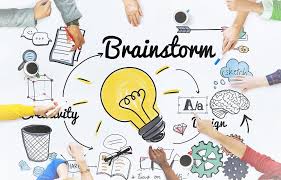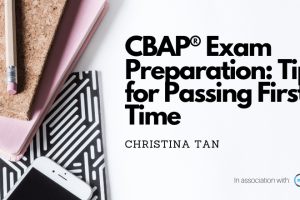
Brainstorming for Creative Thinking
Analytical Thinking & Problem-Solving Competencies is one of the most critical competencies that any individual is required to have in today’s competitive environment. This is listed as one of the competency categories in the BABOK guide and also highlighted as an important competency for a modern analyst in the PMI-PBA Guide as well as in Agile methodologies.
Problem-solving skills requires an individual to be able to understand an environment and the situation, clearly articulate the problem, be able to get to the bottom of the problem through root cause analysis, generate options, perform impact analysis of each solution option and finally be able to recommend the most suitable option to go ahead with.
Creativity is Key
Being creative is a mindset. An individual may bring a certain amount of creativity from birth and also develop it with time. In today’s competitive world, what is required is for someone to think outside the box and to be able to challenge the status quo. Rather than looking at the obvious by touching the surface, it is required to dig deep and be able to explore alternatives. The ability to ask the 5Ws and the 1H (Who, What, When, Where, Why, and How) will help go down multiple paths and be able to generate a diverse set of ideas. This critical thinking and creative mindset will help both in problem identification as well as in solution definition.
Another way to look at creativity is to look at the aspects of left-brain vs right-brain orientation. An individual uses both the left brain and the right brain when dealing with situations. Those who have left-brain inclination are more logical and rational and look at facts, statistics, and reality when making decisions. Those who are right-brain oriented are more emotional, creative, and artistic. An individual through practice or through the conscious application may use the right brain more which will make the problem analysis and the solution identification more creative and interesting.
What is Brainstorming?
As per the BABOK™ version 3, Brainstorming is an elicitation technique used to produce a broad or a diverse set of ideas within a short period of time. Similarly, the PMI-PBA® guide delineates Brainstorming as a data-gathering technique and that it is ideal to identify a large list of ideas from a diverse group of individuals within a very short period of time.
Brainstorming is an ideal technique to stimulate creative thinking. It can be used to identify business needs, explore problems or opportunities, study about risks, discover solution options, or even to come up with different design options for solutions.
Who can Brainstorm?
Brainstorming is typically considered to be a group thinking method. It is more suitable to use brainstorming in a group setting so that the participants can make use of the experience and expertise of others. It encourages individuals to actively listen to ideas presented by others and also to actively contribute by providing ideas, opinions of their own. Hence, participants in a brainstorming session held in a group setting are encouraged to be present with an inquisitive and also a free mind. They are expected not to criticize ideas provided by others but be listen attentively, openly, and welcome ideas. As the old adage goes, ‘Any idea is a good idea’!
Brainstorming can also be performed by an individual. He or she may perform it silently or make it visual through different visualization techniques. Individuals may brainstorm well in quiet settings and when they openly ignite their inner explorer of thoughts.
How is Brainstorming done?
What are the stages of a brainstorming session? How can we make such a session successful? The BABOK® guide describes three main stages of a successful brainstorming activity.
Preparing for the session
Similar to any other activity or task, it is imperative to adequately prepare for a brainstorming session. As with any group activity, a brainstorming session in a group setting is typically led by a neutral facilitator. For a brainstorming activity to be successful it is imperative to select participants who can actually contribute. During the preparation stage, the participants should be identified, and their role in the brainstorming session identified and clearly defined. The participants should be invited, informed about the topic and any pre-reads as applicable should be shared with them.
A person who has a topic or an area of interest might first of all present the same to the group. It might even be the Business Analyst who acts as the facilitator and presents the topic to the group. As part of the preparation, a quiet place should be booked, all required facilities should be arranged (i.e. stationary, whiteboards, sticky notes, pens, food, etc.) and the mood should be set for a good creative thinking session.
It is important that the facilitator also has some sort of interest in the topic as it will help him lead the brainstorming session better. The facilitator should prepare for the session by creating an agenda, and also having a clear picture of how to drive the session and also to keep it on track. Methods for generating ideas, evaluating them, grouping or summarizing them, and finally capturing the ideas in an appropriate manner should be planned. The facilitator must clearly plan how long to spend on idea generation, clarification, grouping, shortlisting, selecting, and capturing ideas.
The brainstorming session
On the day of the brainstorming session, it is imperative that the facilitator and the participants arrive at the venue on time. The facilitator must make sure that everything is in order and all the facilities, equipment, and stationery, etc. are in place. The participants should socialize and get comfortable with each other, especially if it is a group of individuals who have not met each other in the past.
The facilitator must first stage for the brainstorming session. This may be done by setting the ground rules for the session and by encouraging everyone to participate actively when generating ideas. The facilitator will then give the topic and remind about the time boxes to generate, validate, group, select, and capture ideas.
The facilitator will keep the discussion in check by encouraging everyone to participate, by keeping side discussions in a parking lot, and by ensuring that no one attacks others. The ideas generated must be recorded in some manner; as notes on whiteboards, sticky notes, paper, or flip charts. The team will then look to group similar ideas by using the affinity technique and by giving a name for the groups. The participants may select the most suitable or preferred ideas using voting techniques (dot voting, weighted criteria). The selected idea(s) may be built upon further through further rounds of brainstorming amidst the guidance of the facilitator.
Note that if it is a really large group of participants, the facilitator may put them into smaller groups and even put them into breakout rooms. This way the discussion can be more focused and be used to cover even multiple related topics at the same time.
Wrapping-up the session
A brainstorming session needs to be ended appropriately, similar to any other elicitation activity. The following are some things to be done when ending a brainstorming session.
During the wrap-up, the facilitator may first get everyone back to the main room. Elicitation results written on whiteboards, flip charts, etc. may be brought back and made visible to the entire group. The facilitator may then present the ideas discussed, count the votes, and finalize the ideas elicited during the session. The team will agree upon a set of ideas to take forward which will then be documented in a format that can be shared among the participants and other stakeholders. Finally, the brainstorming results will be shared among the stakeholders via email, via electronic media, or even in hard copy format. Ideas up for discussion in future sessions may be agreed upon before the team adjourns.
Types of brainstorming
There are different ways in which Brainstorming can be performed. Here are a few brainstorming techniques as specified in the PMI-PBA® guide.
Free-Form
A free-form brainstorming session gives freedom for participants to contribute to the discussion in their own accord. The facilitator presents the topic or the problem to be discussed and the participating are given the freedom to contribute at any point in time without any restriction. There is a high chance of a free-form brainstorming session getting out of hand and becoming chaotic, especially when discussing highly sensitive topics or when it is full of dominant participants. Likewise, if introvert or conservative type of participants attending the session may result in them being silent and not being willing to contribute to the discussion. This may result in some key ideas been left out.
Round Robin
The round-robin brainstorming technique helps solve issues seen in free-form brainstorming sessions. Each participant in the discussion is allowed to voice his or her opinion one after another similar to the round-robin activity in a Toastmasters session. The facilitator gives the topic and defines an order in which ideas will be taken by participants. The first person gives his or her idea and passes the baton to the person next in line. This continues until everyone in the room has had a chance to give their ideas.
The round-robin technique is suitable as it ensures that even the silent participants are also encouraged to talk. There are drawbacks in this technique as well where participants later on in the queue may not have new ideas to give or their ideas have already been given by another person. This may result in them just passing the baton to the next person without giving any new idea. Secondly, there might be a limited number of ideas generated through the brainstorming session if participants keep building on ideas given by the previous person rather than giving new ideas of their own.
Silent Writing / Pencil & Paper / Brainwriting
I’m sure you all have written your questions on a piece of paper and passed it to your lecturer during your college days. This is the idea behind the silent writing brainstorming technique. Introverts or those who have highly sensitive ideas may prefer to write down the idea on a paper or a sticky note rather than explain the same in public. This method allows people to express ideas while maintaining their anonymity. The disadvantage of this technique is the fact that the amount of information that one can write on a paper is limited which may result in the correct idea not getting across to the relevant stakeholders. The technique also puts an additional burden on the facilitator as he or she now needs to collate the information, write it down on the board or read it out in public.
Mind Mapping
A more visual method of brainstorming where the team tries to show the ideas generated in the form of a diagram. The Main Topic is put in the middle of the diagram drawn on a paper or even on a whiteboard. Topics related to the main topic are then drawn and linked to the main topic. The participants may then keep on breaking down the topics into sub-topics and leaf nodes until all their ideas are put on the canvas. Mind mapping is an ideal technique to group ideas into similar categories and also helps in identifying themes or groupings of information.
Nominal Group Technique
The nominal group technique is usually carried out to generate a few key ideas from a group of Subject Matter Experts (SMEs). This technique involves a formal process and is led by a skilled, knowledgeable facilitator. The facilitator as with other brainstorming variations needs to first define the objectives of the session. The participants build upon the topic and generate more detailed ideas. This may be done by the experts silently and anonymously. The ideas are then grouped into themes and listed down on a whiteboard so that everyone else can see them. Each participant is given the chance to clarify doubts about any of the ideas generated by the others in the group. The facilitator then conducts a round of voting (using dot voting technique) where each participant is requested to vote for ideas based on the order of preference. The ideas that receive the highest number of votes are prioritized and taken up for another round of discussion. This process is continued for a few more rounds until a concrete set of prioritized ideas is detailed out and agreed upon by the group of SMEs.
Conclusion
Brainstorming is a highly collaborative technique that can be used by any organization. The technique is useful for innovative organizations that intend to work on the collective thinking power of their employees. We encourage you to use this technique appropriately to gain the full benefit of this widely used elicitation technique.



